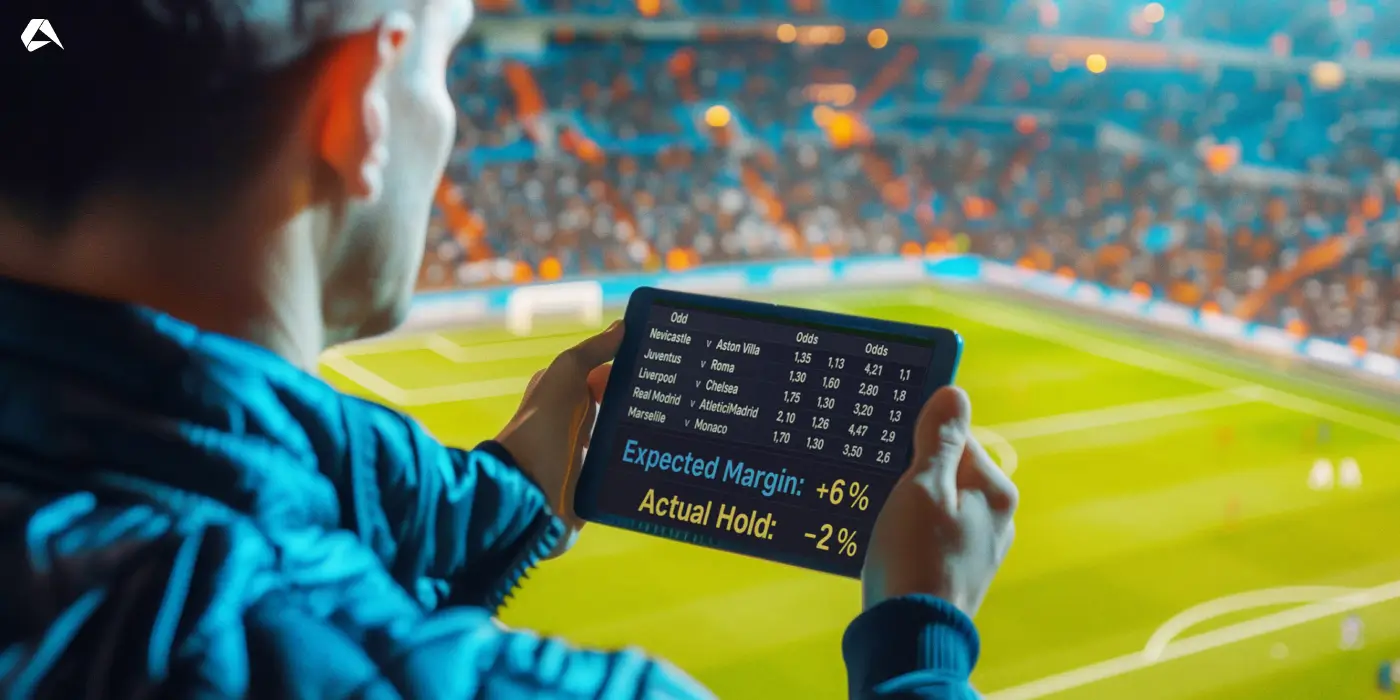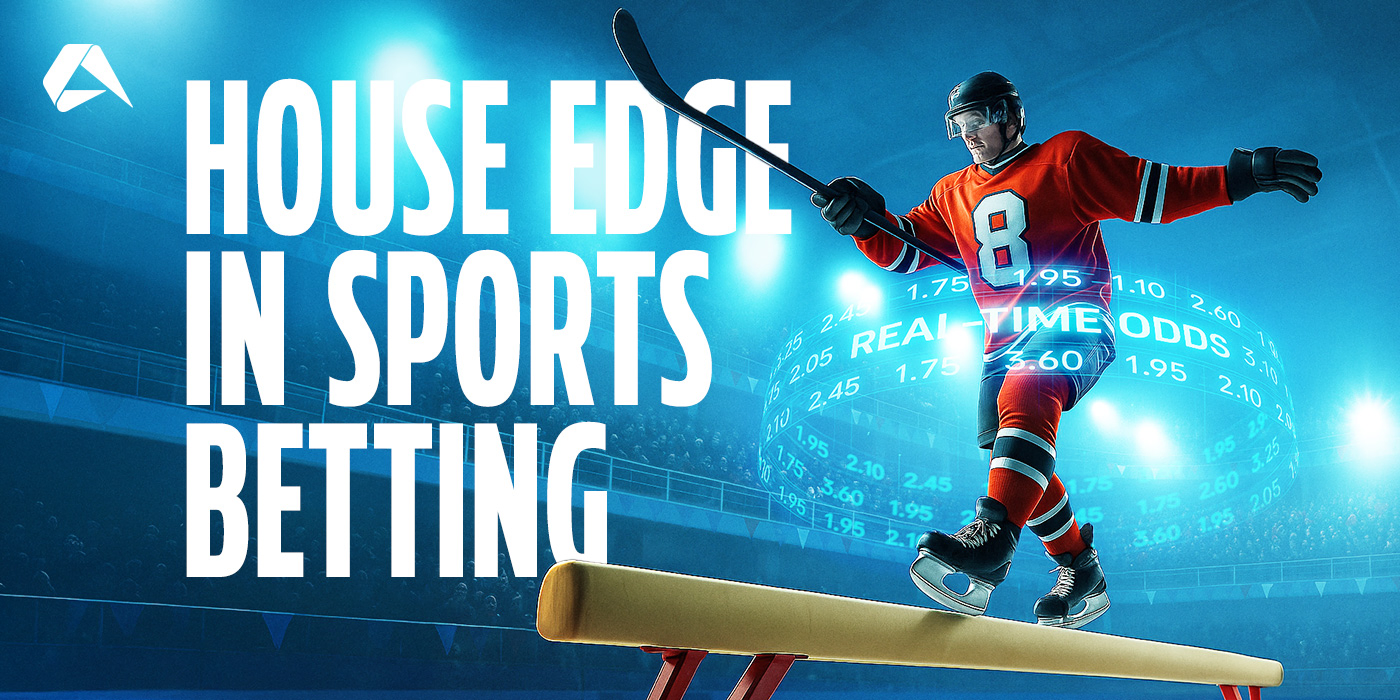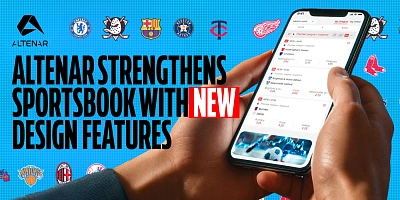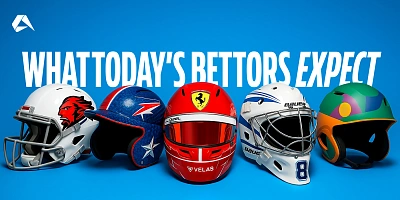Overview House Edge in Sports Betting: How the Best Sportsbooks Manage Their Edge
The house edge in sports betting is a sophisticated theoretical margin built into the odds, distinct from the fixed statistical advantages found in casinos.
For operators, managing this margin requires separating three related concepts: House Edge (the expected profit/forecast), Overround (the margin applied to the odds, resulting in implied probabilities totaling over 100%), and Hold (the actual percentage of stakes retained after settlement, or realized profit).
The theoretical edge is merely a forecast and often fails to materialise due to volatility, lopsided betting volumes, unexpected results, or promotions. Therefore, the edge functions as a strategic lever, dynamically tailored to reflect risk and commercial priorities. Margins are adjusted based on the sport (e.g., tighter for competitive markets like top-tier football; higher for exotic bets), geography (tolerance for margin varies by region), and player segment.
Protecting this edge is an operational strategy requiring real-time risk monitoring and human expertise. Trading teams actively intervene to rebalance exposure, respond to sharp action, and apply judgment to ensure the theoretical margin translates into a realized profit (Hold). Sustainable profit relies not just on the initial pricing model, but on intelligent management of market dynamics.
Read the full blog for a deeper dive into how sportsbooks build, monitor, and protect their edge in real time
What Is House Edge Really?
Ask someone in the casino world what “house edge” means, and they’ll likely give you a straightforward answer along the lines of ‘it’s a built-in statistical advantage that guarantees the house comes out ahead over time’. But in sports betting, it’s not quite so straightforward. The edge still exists, but it doesn’t come from fixed rules or a spinning wheel. It’s built into the odds. And how that edge plays out, like whether it turns into profit or gets wiped out by a well-timed underdog win, depends on a much more sophisticated and less predictable set of moving parts.
For operators, understanding house edge requires more than basic knowledge of how much they stand to earn from a market. An understanding of how that margin is created, how it behaves under pressure, and how to manage it across sports, geographies, and player types is needed. For experienced bettors, it’s a way of reading between the lines and spotting when a market gives too much away, or when a bookmaker is playing it safe.
To get to the bottom of it, we need to separate three concepts that are often lumped together; house edge, overround, and hold. They’re related, but not the same thing. Let’s break them down.
House Edge (Theoretical Margin)
This is the operator’s expected profit built into the market. It’s the margin you’d keep over time, assuming balanced stakes and fair outcomes. In simple terms, if your odds imply a 94% return to player, the theoretical edge is 6%. But that’s a best-case scenario, and essentially a forecast, not a promise. Furthermore, this holds only if the betting volume and results fall neatly into place.
Overround (Built Into Odds)
Overround is how the house edge is applied. It’s the total of all implied probabilities in a market, and it usually adds up to more than 100%. That difference is the operator’s cushion. For example, in a football match where the home win, draw, and away win odds (1X2 Market) add up to 106%, the extra 6% is the overround. That’s where the margin lives. It’s visible if you know how to calculate it, but most bettors typically don’t notice, and that’s the point.
Hold (Realized Profit)
Hold is what actually happens once the dust settles. It’s the percentage of total stakes that the operator retains after settling all bets. Sometimes it lines up with the edge you built in. Sometimes it doesn’t, especially if the money was lopsided or an unexpected result came in. A strong theoretical edge won’t save you from a losing weekend if bettors all land on the right side of the outcome. In summary, hold is the real-world readout, not the plan on paper.
Edge on Paper, Exposure in Practice
To provide a practical example, imagine you’ve priced a Premier League match using a standard 1X2 market (that’s home win 1, draw X, or away win 2). You’ve built in an overround of 106%, which gives you a 6% theoretical edge. But if 80% of the stakes go on the away win, and the away team pulls it off, your actual hold could be close to zero or even negative. That 6% wasn’t a guarantee, it was a cushion, and sometimes this edge is just not enough.
How Sportsbooks Build Edge into Odds
Once you understand what the house edge is, the next step is seeing where it shows up. In sports betting, this typically involves examining how it’s incorporated into various types of markets.
In a two-way market, such as a tennis match, the margin is split between just two outcomes. The pricing has to be more precise, because the market’s tighter and the action moves quickly. In a three-way market like football’s 1X2, there’s an extra outcome to work with (the draw), which gives operators more space to build in margin. Then you’ve got the multi-way or exotic bets, like correct score, first goalscorer, accumulators, etc., where the edge is often heavier, and players are less sensitive to price.
That structure matters. Big events with high turnover usually run on thinner margins to stay competitive. Lower leagues or casual betting markets, on the other hand, tend to carry more edge. Not because they’re unfair, but because that’s where the risk, volatility, and lower scrutiny reside.
In addition, how the odds are presented also matters. A price that looks fair attracts greater betting volume, even when the margin is still doing its job.
Where Edge Meets Reality - Expected vs Actual Profit

Building margin into the odds is just the starting point. What happens once the bets come in, and how those margins hold up under pressure, is where things get interesting. Every bookmaker starts with a theoretical edge, but that gap between what you price for and what you walk away with is where a lot of profit can slip through the cracks.
Let’s say you build a market with a 6% edge baked into the odds. That’s your expected margin, your forecast if you like, based on a balanced flow of bets across different outcomes. But then the majority of your handle lands on one side, and that side wins. Suddenly, your 6% disappears, or worse, turns into a negative hold. That’s not bad pricing. It’s just the reality of volatility in live markets.
Promotions also play a part. Free bets, odds boosts, and early payout offers eat into the theoretical edge, even before a ball is kicked. Add in sharp action (bets placed by highly skilled or professional bettors), syndicate movement, and betting volume imbalance, and you’ll find the actual hold often drifts from the neat models you started with.
Understanding this difference is what separates a pricing model from a profit engine. Theoretical edge gives you a target, but managing exposure, shaping bet distribution, and adjusting in-play are what bring that target to life, or drift it out of reach.
The Edge Isn’t Static — It’s a Strategic Lever
The difference between theoretical and actual profit, therefore, usually comes down to one thing. The edge isn’t static, and it shouldn’t be. It moves, bends, and adapts depending on the market, the audience, and the broader business strategy.
Some markets demand thin pricing just to stay in the game. Others can carry extra margin without affecting volume. It all depends on who’s betting, what they’re betting on, and where it’s happening. For these reasons, the most astute operators don’t apply a blanket margin across the board. They tailor the edge to reflect risk, liquidity, and commercial priorities.
To fully understand how the edge truly functions, you need to look at how it shifts across different contexts in terms of the sport, region, and player type.
By Sport
A Champions League fixture isn’t priced like a darts match. Popular sports like football, basketball, and tennis tend to attract sharper, more knowledgeable bettors, resulting in more line movement, which often keeps margins tight. In contrast, niche sports or novelty markets allow for more breathing room. The sharper the market, the slimmer the edge. That’s the trade-off.
Typical Overround Ranges by Sport and Market Type
Of course, margin isn’t just shaped by what’s on the pitch. It’s also influenced by where the bettor is and how they behave. But before we look at those factors, it’s worth grounding ourselves in how margin typically looks across major sports and types of betting markets.
| Sport / Market Type | Typical Overround Range | Notes |
|---|---|---|
| Top-tier Football (1X2) | 104% – 107% | Lower margins due to volume, sharp action, and market maturity. |
| Lower-league Football | 107% – 110% | More volatility and less scrutiny allow for a higher built-in edge. |
| Tennis (2-way market) | 102% – 105% | Highly efficient market. Sharp money often forces tighter margins. |
| Basketball (spread / ML) | 104% – 106% | Competitive pricing is needed, especially in major leagues like the NBA. |
| Parlays / Accumulators | Variable (115%+) | Implied margin stacks per leg and often yields the highest operator hold. |
| Correct Score / Specials | 110% – 120% + | Low liquidity and high risk allow for heavily padded pricing. |
| Esports | 106% – 110% | Edge varies by title and audience profile. |
Once those benchmarks are set, operators then refine the edge further based on geography. Pricing that works in Spain or the UK might fall flat in Brazil, where players have a higher tolerance for margin and a different sense of value.
By Geography
Player tolerance for margin typically varies by region. In Latin American markets, overrounds of 8–10% are still standard in some sports, whereas European audiences might reject anything above 5%. Operators adjust accordingly, not just for regulatory reasons, but also for cultural expectations surrounding pricing and perceived fairness.
By Segment
A price-sensitive player checking multiple sportsbooks needs tighter odds to convert. But a VIP betting out of habit or convenience may accept a bit more margin in exchange for service. Knowing who you’re pricing for and how they play turns the edge into a targeted tool, not a blunt instrument.
The Psychology of Pricing
What Players See (And What They Don’t)
In reality, bettors don’t need to calculate overrounds to know when something feels off. A difference of a few decimal points, or a price that just seems tight, can quietly push them elsewhere. That’s why odds presentation is more than a technical detail and should be part of the player experience.
Small things shape trust. Rounded odds feel cleaner. Consistent payout patterns signal reliability. And in competitive markets, even casual bettors develop a sense of what’s fair and what’s not, especially for those who regularly browse multiple sportsbooks or use bet comparison tools.
This becomes even more important in price-sensitive segments, where loyalty is often fragile. A price that’s slightly out of line can suggest the operator is squeezing the margin, even when the actual edge is no different from a competitor’s.
Ultimately then, perception shapes behavior. Players don’t respond to margin, they react to how it feels. And when the presentation of odds supports a sense of fairness, the edge becomes easier to hold and harder to detect.
What The Smart Players Know (And Why It Matters)
Up until now, we’ve examined the house edge from the operator’s perspective, considering how it’s priced, where it flexes, and what factors affect the final margin. But the best bettors aren’t blind to any of this. In fact, some know the edge better than the teams who build it. And when they act, they don’t just place bets, they test your pricing model.
These are the value hunters. The line watchers. The ones who know what a 107% market should look like, and what it doesn’t look like. They compare odds across sportsbooks, flag mispriced outcomes, and pounce on early lines before the market settles. And while they may be small in number, they have a way of disproportionately shifting outcomes, especially in more volatile or lower-liquidity markets.
For operators, this should never be viewed as a problem but as a signal. A surge of well-timed bets can highlight risk exposure or pricing imbalance before your models do. That’s why many trading teams use sharp action as a feedback loop, adjusting their lines in real time based on that pressure.
But there’s a second group too. The almost-sharp, you might say. These are experienced recreational customers who read odds, track value, and know when a price feels generous. They’re not trying to break your model, but they’ll still stress-test it in ways that weaker bettors won’t.
Understanding how these segments behave enables operators to make more informed decisions about margin, segmentation, and market timing. Because in a competitive market, every edge you give away, even unintentionally, is one that someone will eventually spot.
Tools to Monitor, Adjust, and Protect the Edge
Once the market goes live, maintaining margin becomes a moving target and a daily discipline. Moreover, in today’s sportsbook operations, keeping that margin intact means staying responsive not just to market movement, but also to what’s happening inside your own book.
Most professional trading teams now rely on real-time risk monitoring to stay ahead of exposure. These tools track sharp action, watch for imbalances and remain alert to sudden shifts in stake distribution, or moments where volatility creeps in faster than expected. In practice, it’s about knowing where the pressure is building before the results come in.
Then there’s player-level margin analysis. Over time, the difference between expected and actual hold often comes down to bettor composition. Seeing how different segments perform against your markets and how that affects your profitability makes it easier to respond with control, not guesswork.
And let’s not forget that automation plays a growing role here, too. When platforms allow for dynamic margin adjustments based on time, volume, or risk thresholds, teams are better equipped to focus on strategy rather than firefighting.
Altenar supports this kind of operational rhythm with built-in tools that give operators the flexibility to adjust margins in real time, track player impact, and identify where the edge is holding and where it’s slipping.
The Role of the Trading Team Behind the Tools
This naturally leads to the fact that protecting the edge isn’t just about technical tools and systems. It’s about knowing when to trust them and when to override their decisions. Behind every margin adjustment, risk trigger, and market shift, there’s a trading team working in the background, established to apply human judgment, experience, and split-second decision-making to protect what appears to be a static number on the screen.
These teams react to sharp action and rebalance exposure. They’re actively shaping the edge itself. When pricing starts to drift, or bet volume stacks unevenly, it’s the traders who intervene to defend the book’s long-term profitability. And in many cases, it’s that intervention, and not the original margin, that saves the hold.
So where the house edge might begin in the model, it’s the trading teams that translate it into realized gain. That’s especially true for in-play betting, where margin erosion happens quickly and sharp money moves faster than the market.
Understanding this process gives operators a clearer picture of why the edge isn’t just mathematical. It’s human, reactive, and deeply tied to the quality of your trading team.
Edge Isn’t Just Math - It’s Operational Strategy
Any sportsbook can build a margin into the odds, but the operators who consistently perform do much more than simply calculate the house edge. They expertly manage it across every layer of the business. From how markets are priced and monitored to how players are segmented and risks controlled, the house edge in sports betting becomes a strategic tool. It’s applied, adjusted, and protected in real time. That’s where sustainable profit lives. Not in the numbers alone, but in how intelligently they’re used.
Want to see how elite operators manage their edge in real time? Request a product demo now and discover the tools that help Altenar’s trading teams hold their ground under pressure, and the pricing logic behind some of the world’s most agile sportsbooks.













